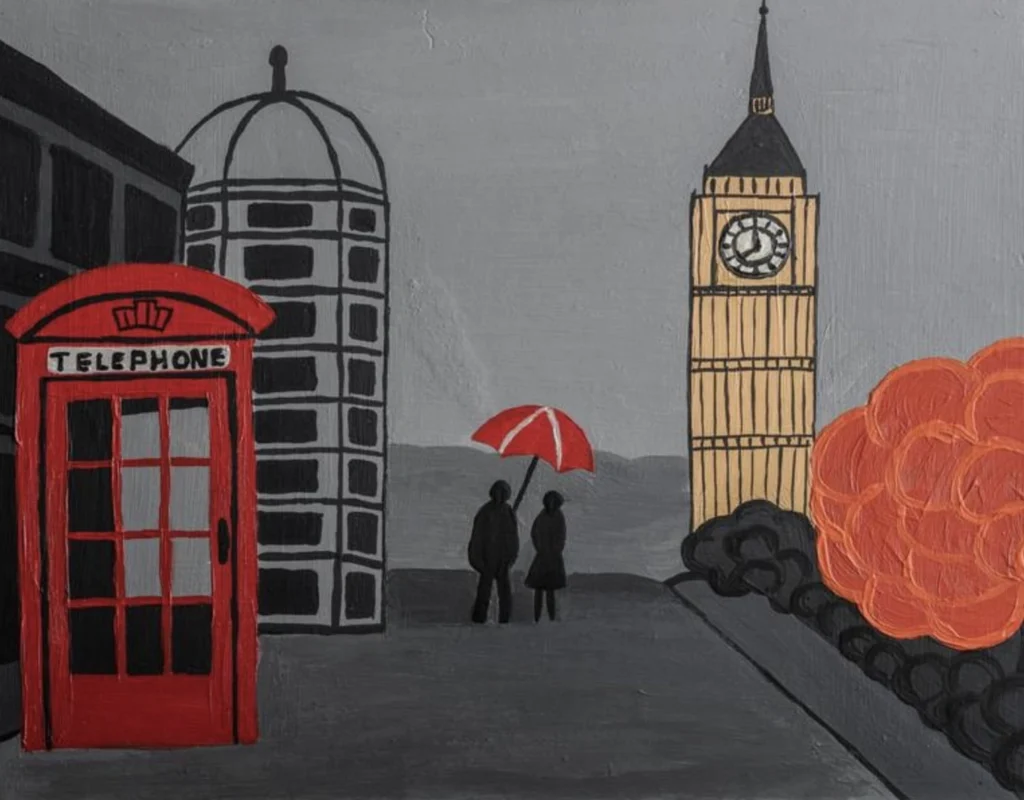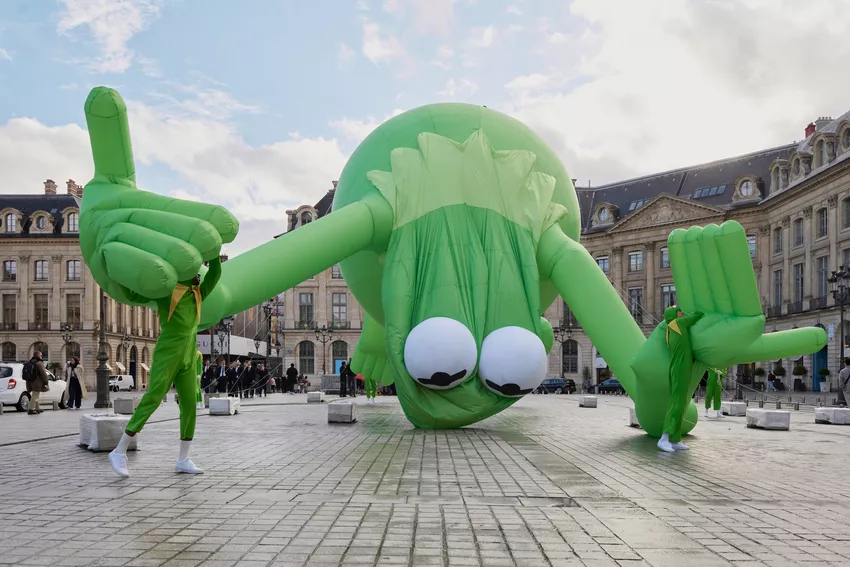There is a peculiar magic in the way artists from elsewhere see London — not as a city of millions, but as a myth, a weathered stage where time and memory keep replaying the same grey afternoon. The “London Streets” print by Georgian painter Arina Iastrebova belongs to this tradition: an image at once naïve and precise, nostalgic and cinematic.
Rendered in muted greys, blacks, and creams, with bursts of red and orange, Iastrebova’s composition captures what feels like the eternal London — the London of postcards, novels, and half-remembered walks through drizzle and streetlight. But her painting is not a cliché. It’s a condensation of emotion, distilled through the simplicity of line and the boldness of contrast.
flow
Iastrebova, born in Georgia and educated in fine arts, approaches urban space with an outsider’s clarity. Her London Streets Print (2024) reinterprets some of the city’s most recognizable icons — the red telephone booth, the towering Big Ben, the umbrella, and the soft geometry of Georgian architecture — through a folkloric visual syntax that feels both personal and universal.
In this piece, London is not bustling. There are no buses, no crowds, no signage, no chaos. Instead, two small figures — perhaps lovers, perhaps travelers — stand under a red umbrella in an empty square. The city around them is simplified into archetypes: the clock tower, the dome, the telephone box. These are not tourist symbols but emotional anchors, signifiers of presence and distance, of belonging and observation.
The palette does much of the emotional work. Grey dominates — not dull, but alive with undertones of blue and smoke. The red of the umbrella and telephone box slices through the melancholy like memory itself, too bright to fade. It’s the same red that has come to define London’s global visual identity, here reimagined as a sign of human warmth amid the city’s cold theatricality.
quiet
Compositionally, London Streets obeys a strict balance that reveals Iastrebova’s formal discipline. The telephone booth anchors the left side, solid and architectural; Big Ben counterbalances on the right, its ochre tones and clock face drawing the eye upward. Between them, the figures form a bridge of intimacy — the human element that holds the geometry together.
The background flattens into almost graphic abstraction. Perspective is minimal; depth is suggested rather than drawn. The brushwork, though sparse, conveys tactile immediacy. You can almost feel the grain of the surface beneath the paint, an echo of rain on pavement.
The orange bloom at the lower right adds mystery: is it a tree, an explosion of autumn foliage, or an abstract memory breaking through the composition? It introduces warmth into an otherwise industrial palette, suggesting that even in the greyest city, something organic insists on color.
This quiet, near-silent arrangement is the essence of Iastrebova’s style — she paints the pause between moments, the hum of stillness that urban life rarely allows.
style
To understand the emotional tone of London Streets, one must look at Iastrebova’s Georgian roots. Georgia’s visual tradition — from medieval frescoes to 20th-century primitivist painters like Niko Pirosmani — emphasizes symbolic clarity over realism. The emotional truth of an image outweighs its technical accuracy.
Iastrebova channels that lineage through a modern lens. Her work is not “folk art” but it shares folk art’s honesty — its disregard for linear perspective, its fascination with archetypes, and its ability to compress complex emotion into flat shapes and color planes.
By applying that visual philosophy to London, she achieves something rare: an image that feels universal without losing its sense of place. Her London is both personal and archetypal — an imagined city that could belong to anyone who has ever felt small beneath its rain.
symbol
Every element in London Streets carries symbolic weight. The red telephone box — once a symbol of connection — now reads as a relic of communication, a monument to analogue contact in a digital age. Its presence beside the anonymous figures suggests nostalgia for closeness, for words spoken rather than typed.
The umbrella, half-open, becomes a metaphor for both protection and fragility. It shelters but cannot fully defend against the weather — much like affection in the face of time.
And Big Ben, always the emblem of London’s endurance, stands here not as authority but as witness. Its clock face reminds us of the passage of time, but the painting’s frozen stillness resists that passage. Time, in Iastrebova’s London, is suspended — a perpetual late afternoon where nothing happens and everything lingers.
The orange tree or bush on the right introduces ambiguity. It could represent autumn, memory, or warmth. It might also signify the artist’s own presence — an emotional intrusion, a trace of Georgian sunlight breaking through the English gloom.
minimal
There is a discipline to Iastrebova’s restraint. By reducing London’s clutter to a handful of icons, she creates space for feeling. Her minimalism is not emptiness; it’s clarity.
This approach aligns her with a broader contemporary movement among Eastern European painters who blend figurative clarity with conceptual understatement — artists such as Tamuna Sirbiladze, Eteri Chkadua, and Maia Naveriani. They share a refusal of excess, a trust in the symbolic economy of form.
In Iastrebova’s hands, minimalism becomes mnemonic. Every object in London Streets is a memory anchor: the phone box recalls missed connections, the clock suggests waiting, the umbrella marks companionship. The viewer supplies the story.
emotive
London’s weather has long been a metaphor for mood — think of Turner’s fogs, Whistler’s nocturnes, or even the cinematic rain of Notting Hill. Iastrebova’s painting continues that lineage but translates it into a modern visual idiom.
The sky is flat grey, devoid of depth or movement. Yet this very flatness radiates emotion. It feels like the quiet after a conversation, or the pause before dusk. The figures’ faceless silhouettes invite projection — they could be lovers, friends, ghosts, or simply strangers sharing shelter.
The red umbrella above them glows like a flame against the monochrome landscape. In that moment, the city becomes secondary; the act of companionship takes center stage. London, usually overwhelming, is rendered intimate.
urban iconography
London Streets joins a lineage of artworks that reinterpret iconic architecture through emotional abstraction. Like Lowry’s industrial silhouettes or Ruskin’s poetic studies of cathedrals, Iastrebova’s London is not about accuracy but atmosphere.
Her inclusion of the red telephone booth situates the work within pop-cultural memory — evoking everything from The Beatles’ album art to 1960s British cinema. Yet her treatment strips it of irony. What might have been kitsch becomes elegiac.
The clock tower, stripped of detail, becomes pure symbol — the geometry of time rather than its mechanism. The buildings beside it lose their realism and gain rhythm, forming a pattern that feels almost musical.
This approach echoes the works of naïve modernists like Henri Rousseau and Alfred Wallis, who likewise painted worlds they felt rather than saw.
impression
Arina Iastrebova’s London Streets Print transforms one of the world’s most photographed cities into something private and poetic. Through restrained composition, symbolic color, and emotional precision, she distills London’s identity to its essence: grey light, red warmth, human connection under the rain.
It is a vision of London not as metropolis but as mood — a city that lives inside the heart of those who have walked its pavements and felt the quiet hum of its weather.
In her hands, icons become intimate, and landmarks become lullabies. The red umbrella, the telephone box, the clock tower — all become instruments in a symphony of stillness.
For all its simplicity, London Streets is a work of depth and tenderness — a love letter written in greyscale, addressed to a city that never truly stands still but, for a fleeting moment in Iastrebova’s frame, finally pauses to listen.
No comments yet.








